 |
To Main Menu The 1997 Fire
This page brings together all of the articles previously presented on this website that reported on the 1997 Chapel fire in Turin. Each article is dated to indicate when it first appeared on the website and has been updated with newer information wherever available. The links to the initial articles on the "Late Breaking Website News" page have been deleted and replaced with new links to this page. All future updates on the fire and chapel reconstruction will be included on this page. The articles appear in the order in which they were first presented, with the most recent one at the bottom of the page. You may scroll through this page in the conventional manner, or use the links included below to go directly to the article of your choice.
Link to a newly published video titled Quando il fuoco aggredì la Sindone (When the fire attacked the Shroud) courtesy of the Center for the International Study of the Shroud (CISS). September 2, 2020.
Link to YouTube Video of the Shroud's Rescue by Mario Trematore. November 26, 2006.
Article 1 - April 12, 1997 - "Special Report on the 1997 Fire"
Articulo 1 - Abril 12, 1997 - "Reporte Especial sobre el Incendio de 1997" - EN ESPAÑOL
Article 2 - April 15, 1997 - "Latest Update on the 1997 Fire" (New Photos Added June 15, 1997)
Article 3 - April 27, 1997 - "Another Update on the 1997 Fire" (New Photos Added May 17, 1997)
April 12, 1997
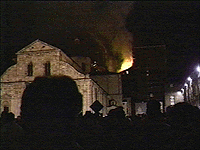
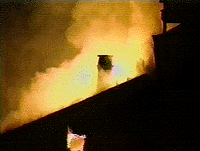
All Frames Taken From Original Footage Courtesy RAI Italian Television
The view from the front of the Cathedral, as flames engulf the Chapel dome and the west wing of the Royal Palace
The Fire and Rescue
For no less than the third time in its recorded history, the Shroud of Turin has faced a dangerous trial by fire and survived. This is an account of the event and its immediate aftermath, taken from a number of sources (see credits at bottom of this page).
At approximately 11:45 p.m., Friday, April 11, 1997, Guido Principe, a citizen of Turin who saw the fire from his home, called in the first alarm. The fire began in either the Dome of the Chapel, which was currently undergoing renovation for the upcoming public exhibitions, or in the west wing of the Royal Palace, which immediately adjoins the back area of the Chapel. In either case, the fire quickly spread to the Guarini Chapel, situated between the Cathedral and the Palace, and engulfed it in flames.
Palace custodian, Giuseppe Ivano said, "We smelled smoke, and then we saw the flames raging from the dome."
Fortunately, on February 24, 1993, the Shroud was moved from the altar of the Chapel to a safer place inside the Cathedral itself while the renovation was undertaken (see map below). Still sealed in the silver reliquary in which it is always stored, it was placed in a special case made of bulletproof glass to protect it. Authorities agree that if it had been in its normal resting place in the altar, it would have been completely consumed by the flames.
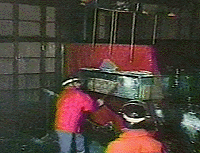
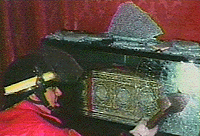
The Turin Fire Department responded almost immediately, and one fireman, Mario Trematore, knowing the important relic was at risk inside, grabbed a large sledge hammer and ran into the Cathedral to effect a rescue. He approached the bulletproof glass and began striking it with the hammer, eventually causing the 39mm thick material to shatter. At that moment, other fireman arrived to assist Trematore and actually helped smash the remaining glass with their gloved hands.
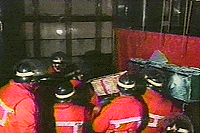
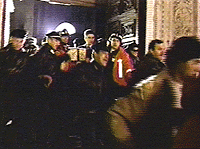
Then, the team grabbed the silver casket from the shattered case and quickly took it out the front of the Cathedral, where it was promptly taken to the apartment of Cardinal Giovanni Saldarini, Archbishop of Turin and Custodian of the Shroud, for safekeeping. Although the flames had not yet reached the area of the Shroud, large pieces of the dome were breaking away and falling to the floor of the Cathedral, putting the firemen at great risk. (Pieces of glass and masonry from the dome and a shattered wall can be seen on top of the case in several of the photographs above). When asked where he found the strength to break the "bulletproof" glass, Trematore replied, "The bulletproof glass can stop bullets, but it cannot stop the strength of values represented by the symbol inside it. With only a hammer and our hands (still bleeding), we broke the glass. This is extraordinary!"
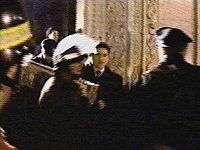
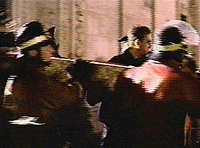
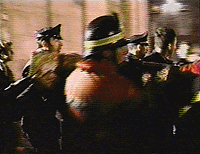
At 1:36 a.m., as the Shroud was carried from the Cathedral by the team of fireman, hundreds of onlookers applauded the rescue effort while many others wept at the sight of the seriously damaged dome. Around 200 firemen continued to fight the blaze for more than four hours, until 4:30 a.m., when it was finally brought under control.
The Damage
As authorities sift through the ashes and rubble left behind by the fire, they must now try and determine the extent of the damages and the possible cause of the blaze. First reports indicate that the interior of the Cathedral and the neighboring Royal Palace, which contains valuable 18th and 19th century furniture and art, sustained extensive damage. The glass wall separating the cathedral and chapel was shattered. The altar, designed by the famous artist Bertola, sustained less damage than originally anticipated. Fortunately, it appears that the scaffolding in place for the renovation of the dome acted to protect the altar from flames and falling debris. However, the chapel seemed to sustain the most serious damage, with two thirds of its marble coating damaged by the heat. It is unclear how much structural damage occured to the building, but reports noted that the stone itself was damaged in places. The cathedral itself received little serious fire or structural damage, but water and smoke damage was evident.
The fire also reached the upper floor of the Royal Palace, where a tower collapsed in flames. Just shortly before the blaze was discovered, an affair attended by U.N. Secretary-General Kofi Annan and Italian Foreign Minister Lamberto Dini had just ended.
''I was struck by the tragic events in Turin last night that seriously damaged places that are dear to the nation's cultural heritage,'' Dini said in a message to Turin mayor Valentino Castellani, noting his ''relief'' that the shroud was saved. The corridor that links the church with the west wing of the Royal Palace burned throughout the night. It was in this same area of the palace that part of the 1978 examination took place. First cost estimates of the damages to the various structures was in the tens of billions of liras and many more billions for the destroyed furniture and art in the Royal Palace.
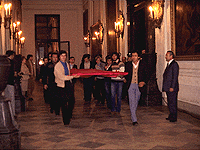
© 1978 Barrie M. Schwortz
In the above photograph, taken in 1978, the Shroud is brought from the Chapel (through the doorway at right) into the west wing of the Royal Palace and down a long hallway to the rooms in which the examination took place. It is unknown at this moment if the actual rooms used by STURP in 1978 were damaged, but the area shown in the photo above (#4 on map below) was definitely destroyed. Reports say that the entire floor in this area is gone.

Key To Map
- Front entrance of Cathedral
- Temporary location of Shroud since February 24, 1993
- Altar inside Guarini Chapel where Shroud is normally stored
- Hallway into west wing of Royal Palace (this area burned throughout the night)
- Swiss Hall, where U.N. Secretary-General affair was held
- The 1978 examination took place in rooms at this end of the hallway
The Aftermath
In an effort to provide the highest degree of protection and security for the Shroud and to allow for a thorough examination of the cloth for any new water or smoke damage, the cloth was moved on Saturday to a monastery near Turin, although the exact location has not been disclosed. Only once before in its 420 year residence in Turin has the cloth left the city, and that occurred during World War II, when it was also moved to a monastery to protect it from possible damage from Allied bombing.
The Turin Chief of Police has formed a special commission to investigate the fire and determine its origin and a number of theories are being examined. Among them are the possibility that the chafing dishes set up in the "Swiss Hall" to heat the food for the U.N. Secretary-General's affair, overloaded the palace circuits and caused a short circuit leading to the fire. Another report stated that a burnt cigarette end was found that might have started the blaze. Turin officials also intend to investigate the restoration work to ensure it was being done according to safety regulations. Saturday, experts from Turin and Rome were taking samples from the wreckage for further analysis. The site was off-limits to all except investigators, although personnel from the fine arts service inspected the dome to see if it was stable.
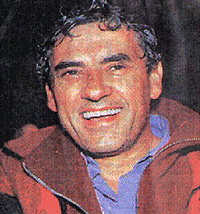
Courtesy "Il Giorno" - ANSA Photo
Heroic Fireman Mario Trematore:
"God gave me the strength to break the glass"On Sunday it was announced that the Pope planned to confer a Papal Honor on the firemen who risked their lives and heroically effected the rescue of the Shroud. Cardinal Saldarini said a mass of thanksgiving on Sunday, in the Sanctuary of Consolata, the most ancient in Turin. The following is the text of his official press release:
The fire which broke out during the night in Chapel of Guarini, next to the Cathedral of Turin, has damaged all the structure and the ornaments of the Chapel itself, but - thanks to God - the reliquary of the Sindon has not been damaged in any way. The building of the Cathedral itself has been entirely saved from the flames, while unfortunately the most serious damage is to be found in the Chapel and in the contiguous building of the Royal Palace. Here, I wish to extend my heartfelt thanks to all those who, starting with the firemen, the Civil Authorities, soldiers and police, did everything in their power during this emergency. The reliquary with the Shroud, immediately removed from the Cathedral, is being kept in a safe place.
This serious episode has happened during the time in which our Church is preparing, in the anticipation of the Great Jubilee of the Third Millenium, for the solemn ostension of the Sindon, in the month of April 1998. The destructive fire, the very serious material damage to a monument of faith and Art, represents however, for all of us Turinese - and for all the world that in these hours - have looked at Turin, a test, an appeal, a Grace. A test of our faith and, also of our capacity as believers and as citizens, attached to those treasures which are out at the roots of our culture and of our combined way of life. Those flames are also an appeal: a precise appeal to the responsibility which we all have, to defend and protect the religious, artistic and historic heritage so closely linked to all our experience as a Church and City. Why did it happen? In today's Gospel Jesus told us "Don't be afraid", something that He can say and that we can hear Him say to us when something terrible happens. The Cathedral, and the Sindon of which I am guardian, have been touched by disaster and saved. It is the way worthy of the measure of God when he says "Don't be afraid". Now we are really assured that he walks on the water, climbs on our boat and leads us to the shore. In faith I give thanks for this sign.
+ Giovanni Card. Saldarini
Pontifical Custodian of the Holy Shroud
Turin, April 12th, 1997
The Future
The best news to come out of this tragedy was a statement by Cardinal Giovanni Saldarini, who said that he had received messages of support and thanks from the Pope and other Church leaders. "The 1998 exhibit of the Shroud would go on as planned", Saldarini said, although no immediate announcement was made of a possible location.
Rebuilding the Chapel
With the ashes of the fire barely cool, plans have already been set into motion on many levels to fund and complete repairs to the damaged Chapel, Royal Palace and Cathedral. Regional leaders, meeting in an emergency session on Saturday, earmarked ten billion lire (5.9 million dollars) to repair the damage caused by the fire. The European Parliament is expected to meet Tuesday in Brussels to decide how much it would set aside for the restoration effort. Italian Deputy Prime Minister Walter Veltroni, who also has a mandate for cultural affairs, said the government would also help out. Veltroni plans to meet with Turin authorities and firemen. U.N. Secretary-General Kofi Annan, saying he was "struck and sorrowful," promised he would ask UNESCO to help Turin financially as well.
On another front, Giovanni Battista Judica Cordiglia, the official Shroud photographer in 1969 and 1973, has recently completed a video which will immediately be updated to include images of the fire. He has pledged to donate part of the profits from its sale for the reconstruction of the Chapel. More information about the video, including ordering information, will be posted on this website as soon as it becomes available.
In spite of this near tragedy, it seems that once again, the Shroud of Turin will endure. For anyone who knows its history, this is not a surprise. As mentioned at the beginning of this article, the Shroud has had previous "trials by fire". The most significant was on December 4, 1532. While stored in the Sainte Chapelle in Chambery, the cloth itself was damaged when that cathedral also caught fire, causing such extreme heat that the silver casket or reliquary in which it was stored began to melt. When this was discovered, water was poured over the reliquary, quenching the fire, but not before hot, molten silver dropped onto the folded cloth inside, damaging it and causing the now familiar pattern of burns extending along both sides of the image. In 1534 these burn holes were repaired by the Poor Clare Nuns, who sewed patches into the largest holes and attached a full size backing cloth to the Shroud (known as the Holland Cloth) to strengthen it. Also apparent on the Shroud are four sets of four burn holes in an "L" shape. Historians generally agree these were not caused by the 1532 fire but by an earlier undocumented event. An illuminated Hungarian text from 1204, called the Pray Manuscript, includes an illustration of the Shroud and shows these unique burn holes.
Please check the "Late Breaking Website News" page often. It will be updated as soon as any new information becomes available.
Credits
I wish to thank everyone who took the time to provide me with information for this article. Most notably is Maurizio Marinelli, who sent me many late night e-mails over this weekend with the current news from Turin. I also wish to thank Pietro Di Pasquale, of RAI Italian Television for calling me on several occasions with updated information from his excellent sources and for getting me permission to use my "off the air" videotape to grab frames from the incredible RAI Italian Television footage to use as the illustrations in this article. My thanks to RAI for their gracious permission. Also, my thanks to ANSA Italian news service, the newspaper "Il Giorno" and the CNN Interactive website for their great coverage which provided me with several additional sources of information.
April 15, 1997
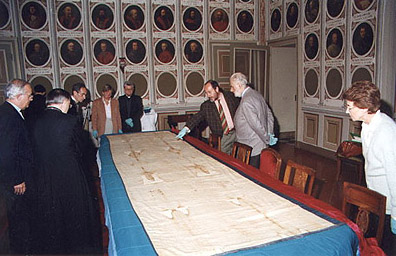
Verification of the Shroud cloth on April 14, 1997. One can note the Pontifical Custodian,
Cardinal Giovanni Saldarini, the Superintendent, Dr. Carlaenrica Spantigati (Turin) and
Dr. Rosalia Varoli Plaza of the Central Institute of the Restoration (Rome) (Archiepiscopal Curia of Turin)
© 1997 A. GuerreschiThe Shroud was unfolded and examined at 9:20 a.m. today, Monday, April 14, in the premises of the Metropolitan Curia of Turin, in the Bishop’s Hall of the Metropolitan Curia in the presence of the Palatine Chaplains of the Cathedral, of the Archiepiscopal Chancellor Giacomo Martinacci and of the Cardinal Archbishop Giovanni Saldarini. Also present were Pierluigi Baima Bollone (University of Turin), Bruno Barberis (President of the International Shroud Center of Turin), Carla Enrica Spantigati (Superintendent of Artistic and Historical Domains of Piedmont) and other members of the Conservation Team of the Shroud. At 11:00 a.m. the Shroud was again folded around a wooden cylinder and placed in the silver and wood casket. The private exhibition took two hours and 30 minutes. At 12:30 p.m. the procedure ended.
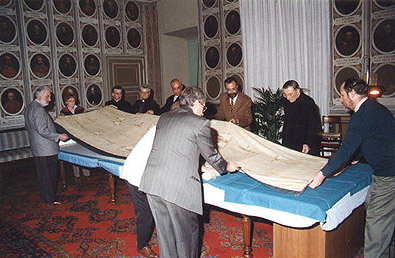
The Shroud is prepared for rewinding onto wooden cylinder. One can note, beyond the
Pontifical Custodian, Dr. Mechtild Flury-Lemberg, Director of the Abegg Museum of Riggisberg-Berna
and Prof. Peter Savarino, Scientific Assistant of the Custodian (Archiepiscopal Curia of Turin)
© 1997 A. GuerreschiTHE SHROUD SUFFERED NO DAMAGE from the fire that broke out Friday night in Turin Cathedral. The Archiepiscopal Curia makes it known in an official press note of 1:08 p.m.:
"The results of the inspection realized on the relic have shown a situation completely regular and in conformity with that verified in the previous exhibitions, from the 1978 on. Harmful effects of any kind are excluded."The casket containing the Shroud had already been opened during the night between last Friday and Saturday to verify possible water infiltrations, but the cloth (that moreover was cold) was not unfolded, since the integrity of the casket and of the seals had already been verified. One wanted to do this further control to remove any doubt in answer to the hundreds of calls to the Archiepiscopal Curia.
The Shroud is still in the Archiepiscopal Curia, contrary to what was stated about a transfer to an unnamed Monastery, although this doesn't mean that it won't be transferred during next hours. However, Cardinal Saldarini stated, "Be calm: as long as I am here the Shroud won't ever leave Turin, not even temporarily. Don't worry: it is here and here it will remain". This declaration dissipates the fears of a transfer of the Shroud outside Turin, both during the restoration of the Cathedral and during the Exhibitions in 1998 and 2000.
Some subscriptions have already been opened to collect funds to reconstruct the Shroud Chapel. In the first 48 hours, 632 million liras have already been collected. Many institutions and organizations that link up with the "Istituto Bancario San Paolo di Torino" have opened a bank account, number 115759, to which payments can be made. The newspaper "La Stampa - Fondazione Specchio dei Tempi", has a postal account, number 7104, to which payments can be made, with the specification "RICOSTRUZIONE CAPPELLA SINDONE"
The initiative of Giovanni Battista Judica Cordiglia, official photographer of the Shroud in 1969 and 1973, who completed a video with the title "SINDONE: ODISSEA DI UN CONDANNATO (SHROUD: ODYSSEY OF A CONVICT)", including images of the fire, is linked to this last chain of solidarity. He has decided to give part of the profits from its sale to the reconstruction of the Chapel. The minimum cost of the video (available both in Italian and in English), is $20.00 US + $2.00 US for postage. Being an operation with charitable purposes, the proposed amount is only relative to the costs necessary for the production. It is possible to order the tape directly by contacting Judica Cordiglia (judicacordiglia@iol.it) or the Collegamento pro Sindone (cpshroud@mbox.vol.it) who will forward the orders to Giovanni Battista Judica Cordiglia. For the payments, an international postal order should be made to "Judica Cordiglia" and sent to:
Judica Cordiglia s.a.s.
Via Arcivescovado, 25/D
10121 Turin - ItalyThe author will keep a rigorous list of the payments that will be furnished on request.
In related news, the Italian Government has appropriated 12 billion liras for the urgent temporary covering to the damaged premises and has decided to set aside 100 billion liras of the estimated funds for the 2000 Jubilee for the reconstruction of the Shroud Chapel.
April 27, 1997
The experts investigating the fire in Turin declared they would need as long as three months to complete their examination to determine the cause and origin of the fire. Also, estimates of the time necessary to complete the restoration of the Chapel have varied, but the consensus is that it will not be completed until at least the year 2002.
Included below are two illustrations of the bulletproof glass strongbox in which the Shroud has been kept since February 24, 1993. Designed by architect Andrea Bruno at a cost of 300 million liras, the opening of the strongbox was regulated by a complex mechanism requiring the use of four special handles in a synchronized manner. The complete opening operation normally took about 30 minutes. These handles were provided to the first firemen on the scene who tried to open the strongbox, but the heat and falling debris had damaged the mechanism and it would not work properly. At that point, with debris falling around them and the great heat from the fire, the firemen decided to use a sledge hammer to break the glass and remove the relic.
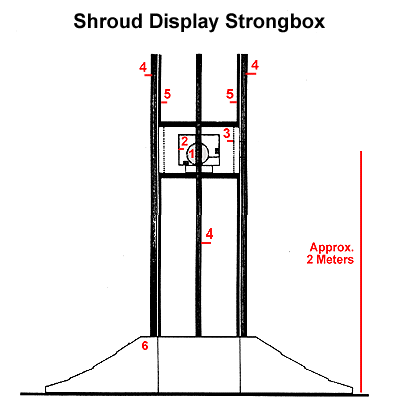
Based On Original Illustration © "Sindon", Issue 5/6, December 1993
Key to Diagram
- The Shroud
- The Silver and Wooden Casket
- Bulletproof Glass Box
- 39mm Thick Openable Bulletproof Glass Sheets
- Tempered Glass Sheet
- Base containing the opening mechanism for the external bulletproof glass sheets
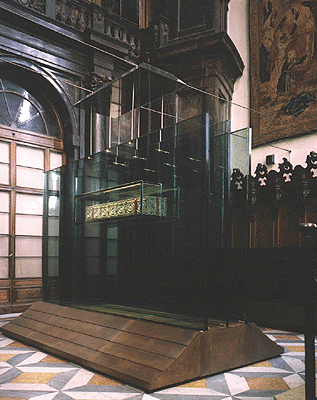
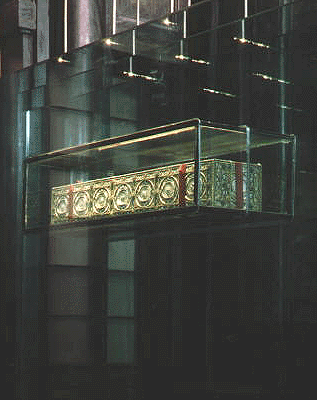
© Patrizia Mussa
Location of the Shroud behind the High Altar prior to the fire
This area was completely destroyed by heat from the fire and the Shroud's rescueOn the morning of April 16th, "La Stampa", a Turin newspaper, published six photographs taken by an amateur during the first minutes of the fire. The photographs indicate that the fire started in the wooden and aluminum scaffolding on the exterior of the dome, although investigators believe the fire started inside the chapel. However, every hypothesis will be thoroughly investigated.
On April 17th, the newspaper "Il Corriere della Sera" published an article describing a new structure in which the Shroud will be kept. It will cost 1 billion lire and the funds are being provided by "ITALGAS", a major Italian utility company. In this new 4 meter by 2 meter bulletproof crystal and stone case, the Shroud will be kept unfolded and monitored by electronic circuitry. An automatic system has been designed for the cloth's easy removal whenever necessary (it will pull out in a shallow drawer). However, it is unclear if Shroud scientists had any hand in the design of this new structure and whether the design can provide adequate protection for the cloth from a conservation standpoint (protection from air pollution, light, etc.).
By April 21st, investigators had excluded an overloading of the electrical circuits in the Palace as the cause of the fire, although all other hypotheses remained valid. The dome itself has been deemed unsafe in its current state. There was no immediate danger of collapse, but the dome has been slung with large wire ropes and its condition is being monitored constantly. The structural damage to the buildings has been estimated at 60 billion lire, but this does not include the many works of art and antique furnishings that were also damaged or destroyed.
In other news, the Piedmont Region approved the assignment of 10 billion lire for the reconstruction work and European Commissioner Marcelino Oreja said he will propose the assignment of 100 thousand ECU. Individual donations have already raised about 830 million lire.
On April 24th, Cardinal Giovanni Saldarini, on the occasion of his visit to the Vatican, stated during a press conference that the Shroud will remain in Turin (contrary to the rumors of it being transferred to Rome). The present location of the cloth will remain secret for security reasons. He also stated that, at the moment, no further scientific examination is foreseen. After the restoration work is completed, the Archbishop said that the Shroud would be permanently stored unfolded, to minimize any damage caused by such folding and unfolding. He also restated that the 1998 and 2000 exhibitions will take place in Turin as originally scheduled.